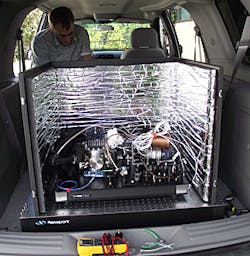NIST stabilized laser takes short but important test drive

Boulder, CO--In a step toward taking the most advanced atomic clocks on the road, physicists at the National Institute of Standards and Technology (NIST) have designed and demonstrated a super-stable laser operating in a cramped, vibrating minivan.1 The experiment shows how advanced lasers can be made both stable and transportable enough for field use in geodesy, hydrology, improved radar, and space-based tests of fundamental physics.
A short off-road test
The drive tests were limited to a short excursion of five meters across the grass at the NIST campus. Scientists evaluated the infrared fiber laser's performance with the vehicle stationary, with the motor alternately off and idling, and moving over uneven ground at speeds of less than 1 m/s (3.6 km/h). The laser frequency remained stable enough with the car parked—the most likely situation in the field—to be used in some applications now, says David Leibrandt, a NIST postdoctoral researcher.
"Our group has been building and using ultrastable lasers for more than ten years, but they're large and delicate," Leibrandt says. "The ones we use for our optical atomic clocks occupy a small room and have to be very carefully isolated from seismic and acoustic vibrations. This paper presents a new design that is less sensitive to vibrations and could be made much smaller."
NIST scientists stabilized the test laser's frequency using a common technique: locking it to the extremely consistent length of a glass optical cavity. The sphere, about the size of a small orange, hangs in a customized mount with the proper stiffness. The scientists also designed a system to correct the laser frequency when the vehicle moves. Six accelerometers surrounding the cavity measure its linear and rotational acceleration. The accelerometers' signals are routed to a programmable computer chip that predicts and corrects the laser frequency in less than 100 microseconds.
The new laser will make it easier to use advanced atomic clocks for geodesy (measurements of the Earth), an application envisioned by the same NIST research group.2 The laser also might be used on moving platforms, perhaps in space-based physics experiments or on Earth generating low-noise signals for radar. Study results indicate the laser is roughly ten times more resistant to undesirable effects from vibration or acceleration than the best radio-frequency crystal oscillators. Improved mechanical design and higher-bandwidth accelerometers could make the laser even more stable in the future, the researchers say.
The research is supported by the Office of Naval Research, Air Force Office of Scientific Research, and Defense Advanced Research Projects Agency.
REFERENCES:
1. D.R. Leibrandt et al., Optics Express, May 23, 2011 / Vol. 19, No. 11. Published online May 10, 2011.
2. See the Sept. 23, 2010, NIST news story "NIST Pair of Aluminum Atomic Clocks Reveal Einstein's Relativity at a Personal Scale," at http://www.nist.gov/public_affairs/releases/aluminum-atomic-clock_092310.cfm.

John Wallace | Senior Technical Editor (1998-2022)
John Wallace was with Laser Focus World for nearly 25 years, retiring in late June 2022. He obtained a bachelor's degree in mechanical engineering and physics at Rutgers University and a master's in optical engineering at the University of Rochester. Before becoming an editor, John worked as an engineer at RCA, Exxon, Eastman Kodak, and GCA Corporation.